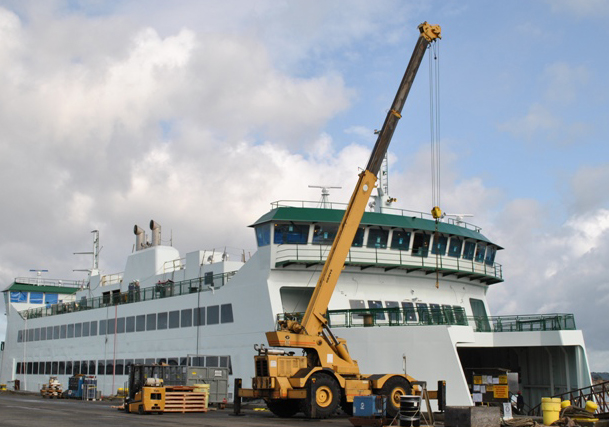A few weeks ago, when a new ferry was inaugurated in Puget Sound, Washington Governor Chris Gregoire smashed a bottle of champagne and declared, “God bless this boat."
It had been three years since the leaky electric boats that had ferried passengers between Coupeville, Whidbey Island, and Port Townsend were retired three years ago. The new ferry – the state's first in a decade – was financed through federally-supported Build America Bonds.

Governor Gregoire said the bonds offered “the lowest interest rates in our state’s history.” The state treasurer's office says the bond sales financed infrastructure projects like the ferry and "sorely needed improvements to I-405, I-5 in Tacoma, and US 395 in Spokane."
“Lower borrowing costs means fewer tax dollars are required for the essential capital projects,” Gov. Gregoire said. “It is an equation that helps everyone: less cost = more projects = more jobs.”
Build America Bonds (BABs) were authorized as part of the stimulus package. They are issued by municipalities, with federal backing, to help pay for infrastructure, and they help metro areas borrow money at a cheaper rate on the bond market. With the power of the gas tax dwindling, BABs have become enormously popular.
In the 20 months since BABs were introduced, they’ve grown to account for about 27 percent of all municipal bonds issued. The Treasury Department reports that more than $150 billion have been issued through the end of October. October, in fact was the biggest month yet for BABs – maybe because metro areas and investors want to get in on the action before the program ends.
Unless Congress acts quickly, the program will expire at the end of this year. Should advocates for transportation reform care whether local governments can keep on using BABs to finance infrastructure projects?
Robert Puentes of the Brookings Institution wants to see BABs renewed, but notes that they are best-suited for short-term financing of local projects. Investing in something like a high-speed rail corridor that crosses state boundaries would require financing mechanisms that have a longer reach and more flexibility to fund projects of regional and national importance. To Puentes, BABs are no substitute for a National Infrastructure Bank, for example, but they are "definitely part of the conversation."
Then there's the question of whether BABs are being used to fund good transportation investments, like necessary road repairs and transit improvements, or business-as-usual projects that perpetuate sprawl. From that perspective, one argument in favor of BABs is that transit agencies can take advantage of them. Washington D.C.'s transit agency, for instance, has used BABs to help pay for a Metro extension.
“There are a lot of folks who are big proponents of this because they’re saying states and localities are using it,” said Puentes. “That should not be the one measure that we’re putting behind this. What is this being used for, where is it being used, and what impact has that had on municipal budgets?”
Getting a thorough answer can be difficult. Treasury says the bonds are financing the construction of “schools and hospitals, development of transportation infrastructure, and water and sewer upgrades,” but it's hard to get your hands on concrete data detailing exactly how the bonds have been used. Some local government officials have admitted to not wanting to "paint themselves into a corner" by putting too fine a point on which infrastructure projects were paid for with funds from which bond issuance.
In any case, the bonds do represent significant savings for state and local governments. Washington state officials say they've saved $220 million in debt service costs on their $1.6 billion in bond issuances.
That’s a great deal for metros. Plus, the bonds are both highly-rated and high-yielding – an unusual combination. Investors normally get a higher payoff for taking a bigger risk. But BABs offer a high payoff with low risk. According to Randall Forsyth at Barron’s, “some triple-A-rated BABs are yielding more than triple-B corporate debt obligations.”
So it’s no surprise that the bonds have been enormously popular with investors and municipalities alike. But with an incoming Republican majority that’s allergic to spending, even this beloved program could bite the dust.
This busy lame duck session isn’t the last chance for Build America Bonds, though. According to CNBC, “Muni traders say there's a growing belief that the program will be permitted to expire, if only to be restarted early in the new year, perhaps as part of a new omnibus spending bill.”





